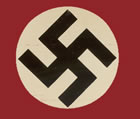
from an article titled "Composer Anton Webern Was Double Agent for Nazis" By Heinrich Kincaid, The Associated Press In what can surely be considered the most brazen instance of Art Imitating Espionage to date, avant garde composers of the Hitler years working in conjunction with designers of the Nazi Enigma code were bamboozling unsuspecting audiences with their atonal thunderings while at the same time passing critical scientific data back and forth between nations. "This calls into question the entire Second Viennese School of music," announced minimalist composer John Adams from his home in the Adirondack Mountains. "Ever since I first encountered compositions by Arnold Schonberg I wondered what the hell anyone ever heard in it. Now I know." Gunned down by an American soldier in occupied Berlin, 62 year old Anton Webern's death was until now considered a tragic loss to the musical world. At the time the U.S. Army reported that the killing was "a mistake", and that in stepping onto the street at night to smoke a cigarette Webern was violating a strict curfew rule. It is now known that Webern was using music to shuttle Werner Heisenberg's discoveries in atomic energy to German spy Klaus Fuchs working on the Manhattan atom bomb project in New Mexico. Due to the secret nature of the project, which was still underway after the invasion of Berlin, Army officials at the time were unable to describe the true reason for Webern's murder. Hans Scherbius, a Nazi party official who worked with Minister of Propaganda Joseph Goebbels, admitted at age eighty-seven that the Nazis secretly were behind the twelve-tone technique of composition, which was officially reviled to give it the outlaw status it needed to remain outside of the larger public purview. "These pieces were nothing more than cipher for encoding messages," he chuckled during an interview on his balcony in Buenos Aires. "It was only because it was 'naughty' and difficult that elite audiences accepted it, even championed it." Physicist Edward Teller, who kept a 9-foot Steinway piano in his apartment at the Los Alamos laboratory, was the unwitting deliverer of Heisenburg's data to Fuchs, who eagerly attended parties thrown by Teller, an enthusiastic booster of Webern's music. Arnold Schonberg, the older musician who first devised the serial technique at the request of the Weimar government of Germany, composed music in America to deliver bomb data stolen by Fuchs back to the Nazis, who worked feverishly to design their own atomic weapons. As an example, Scherbius showed Associated Press reporters the score of Webern's Opus 30 "Variations for Orchestra" overlayed with a cardboard template. The notes formed a mathematical grid that deciphered into German a comparison between the neutron release cross-sections of uranium isotopes 235 and 238. Schonberg responded with a collection of songs for soprano and woodwinds that encrypted the chemical makeup of the polonium-beryllium initiator at the core of the Trinity explosion. And in Japan, Toru Takemitsu took time out from his own neo-romanticism to transmit data via music of his nation's progress with the atom. "The most curious thing about it," says composer Philip Glass in New York City, "is that musicians continued to write twelve-tone music after the war, even though they had no idea why it was really invented. Indeed, there are guys who are churning out serialism to this day." Unlike the diatonic music, which is based on scales that have been agreed upon by listeners throughout the world for all of history, twelve-tone music treats each note of the chromatic scale with equal importance, and contains a built-in mathematical refusal to form chords that are pleasing by traditional standards. Known also as serialism, the style has never been accepted outside of an elite cadre of musicians, who believe it is the only fresh and valid direction for post-Wagnerian classical music to go. "Even if this is really true," states conductor Pierre Boulez, a composer who continues to utilize serial techniques, "the music has been vindicated by music critics for decades now. I see no reason to suddenly invalidate an art form just because of some funny business at its inception." Home / About Music |